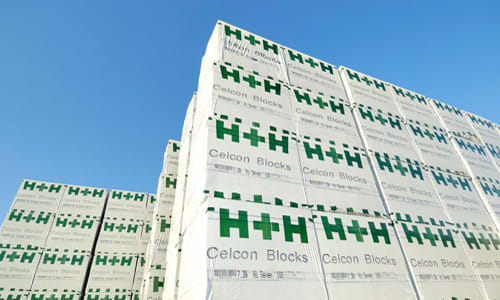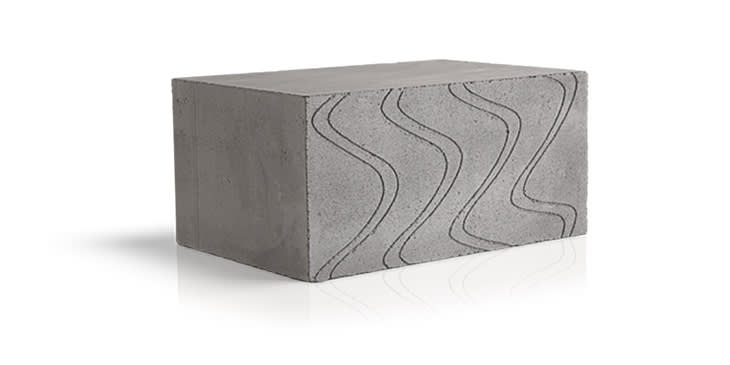Aerated Blocks
(12 Products)Aerated blocks contain a high volume of air (typically over 80%), which is what gives them their low weight and insulating ability. Often called AAC (short for autoclaved aerated concrete), these blocks are light to handle but still strong enough for load-bearing use when specified correctly.
What Are Aerated Blocks?
Aerated blocks are lightweight concrete blocks made using a mix of cement, lime, sand or pulverised fuel ash, water, and a small quantity of aluminium powder. During production, the aluminium reacts with the other materials, forming tiny air pockets throughout the mix. This gives the blocks their low weight and thermal insulating properties.
After mixing, the material is poured into moulds and cured under heat and pressure in an autoclave. This process strengthens the finished product and ensures consistency in density and performance.
You’ll typically find aerated blocks used in internal walls, cavity builds, and infill sections. Depending on the job and the grade of block you’re using, they can handle both structural and non-structural work.
Most fall somewhere between 3.6 and 7.3 newtons per mm² in compressive strength, but that can shift slightly depending on the specific product and its intended use.
They are compatible with most standard finishes and fixings and can be worked with using basic hand tools.
How Aerated Blocks Are Manufactured
Aerated blocks are produced using a blend of cement, lime, fine aggregates (typically sand or pulverised fuel ash), water, and aluminium powder.
It’s the aluminium powder that sets the process apart. As it reacts with the lime in the mix, it releases hydrogen gas, which forms thousands of tiny, evenly distributed air pockets throughout the material.
This chemical reaction causes the mixture to rise before it is cured in an autoclave - a pressurised steam chamber. The high-pressure steam curing (known as autoclaving) plays an important role in hardening the blocks and locking in their strength.
After that stage, they’re cut down to size, ready for use on site. What you end up with is a block that’s much lighter than standard concrete but still solid enough for structural work where required.
Applications
You’ll find aerated blocks used in a wide range of construction work, both inside and as part of the building shell. The exact application depends on the strength and density of the block, but typical uses include:
- Cavity walls (as the inner leaf, with insulation and an external finish)
- Internal structural walls
- Non-loadbearing partitions
- Infill panels between steel or concrete frames
- Floor and roof systems
- Some below-ground walls, where a higher-density block is required
Benefits
- Lightweight and Easy to Handle: One of the first things you’ll notice with aerated blocks is how much lighter they are than standard concrete. That matters when you’re shifting pallets, moving materials by hand, or laying blocks all day. Less weight means less strain and often quicker progress on site.
- Helps with Insulation: Because of the air inside the block, heat doesn’t pass through as easily.You’ll see the benefit most in external walls, where they help limit heat loss. In some builds, you can reduce the amount of extra insulation needed, depending on the spec, which can also free up a bit of space in the wall build-up.
- Fire Safety: Aerated blocks are non-combustible. When used correctly, with suitable thickness and detailing, they can meet high fire resistance standards. That makes them a dependable option on jobs where fire performance is a key part of the design.
- Sound Reduction: Even though they’re lighter than traditional blocks, they still help reduce the transfer of sound between rooms or units. That makes them useful for internal walls in houses or flats, especially where acoustic performance matters.
- Workability: Blocks can be cut to size on-site using basic hand tools, and they accept fixings with the correct proprietary plugs. They work well with most internal finishes. You can plaster straight onto them, use adhesive for dot-and-dab, or go with traditional dry lining, depending on the job.
Strength and Density Options
Most standard options fall somewhere between 3.6 and 7.3 N/mm² in compressive strength, though you can get higher grades if the job calls for it.
Lower-density blocks give better insulation but aren’t suited for loadbearing. Higher-density blocks offer more strength and better impact resistance, which makes them suitable for structural walls or areas that take more wear and tear.
Handling and Storage on Site
Aerated blocks are more forgiving to handle than dense concrete, but they still need proper care before use.
They should be kept off the ground, ideally on a level pallet, and covered up if there’s any chance of rain. If they get saturated, it can affect workability and delays finishing. Best to keep them dry and protected until needed.
Working with Aerated Blocks
- Cutting and Service Chases: Aerated blocks are easy to cut with a handsaw, which is useful when shaping around pipework or fitting sections to size. Power tools can also be used, but it's best to fit dust extraction if you're working indoors or on enclosed sites. If you’re chasing out for cables or pipe runs, follow structural guidance closely - don’t go deeper than recommended, especially on loadbearing walls.
- Fixings and Finishing Options: Use fixings that are designed specifically for aerated concrete - standard wall plugs won’t give you a proper hold. There are several types available for light and heavy-duty applications. When it comes to finishing, most systems are compatible. You can apply plaster directly, use dot-and-dab with boards, or render externally, as long as surfaces are clean and prepped.
- Managing Moisture on Site: Although aerated concrete isn’t water-sensitive in the way timber is, the blocks are still porous. They can take on moisture if left exposed, so proper detailing is important. Always include a suitable damp-proof course, and use breathable finishes where needed to allow any trapped moisture to escape.
Frequently Asked Aerated Blocks Questions
Can You Drill Into Aerated Blocks?
Yes, aerated blocks can indeed be drilled. They can also be cut, nailed, milled and grooved to accommodate your project needs.
Are AAC Blocks Better Than Brick?
There are a few advantages to using AAC blocks over traditional brick. Perhaps the most obvious of these is AAC's exceptionally lightweight. With this lighter weight, comes a reduction in the amount of cement and steel needed to complete the project, which consequently, lowers costs.
As well as this, AAC tends to be a more economical choice since it is environmentally friendly. They also tend to be more durable and feature enhanced thermal and acoustic properties.
Is Aircrete As Strong As Concrete?
Not exactly - it depends on what you mean by “concrete.” Aircrete (or aerated concrete) is significantly lighter than dense concrete blocks and doesn’t offer the same compressive strength. That said, it’s strong enough for many structural applications when the correct grade is used.
Most standard aircrete blocks fall within the 3.6 to 7.3 N/mm² strength range, which covers everything from non-loadbearing partitions to internal loadbearing walls and some external cavity wall uses.
Dense concrete blocks, especially high-density ones, are used when higher strength is needed, like in retaining walls, foundations, or areas exposed to heavy impact.
In short: aircrete isn’t as strong as dense concrete, but for many wall types in standard construction, it’s strong enough and brings the added benefits of being lighter and more thermally efficient.



.jpg)

.jpg)


.jpg)
.jpg)
